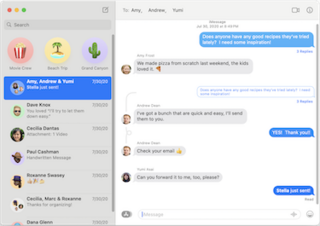Related Research Articles
Voice over Internet Protocol (VoIP), also called IP telephony, is a method and group of technologies for voice calls for the delivery of voice communication sessions over Internet Protocol (IP) networks, such as the Internet.
The Samsung SPH-i550 smartphone is the Palm OS-based successor to the clamshell style SPH-i500. The SPH-i550 has a 320 x 320 internal screen and an external OLED display. The camera takes 1 MP stills and can record video. A built-in MP3 player is controlled by external buttons without having to open the phone.
An over-the-air update, also known as over-the-air programming, is an update to an embedded system that is delivered through a wireless network, such as Wi-Fi or a cellular network. These embedded systems include mobile phones, tablets, set-top boxes, cars and telecommunications equipment. OTA updates for cars and internet of things devices can also be called firmware over-the-air (FOTA). Various components may be updated OTA, including the device's operating system, applications, configuration settings, or parameters like encryption keys.

Secure Terminal Equipment (STE) is the U.S. government's current, encrypted telephone communications system for wired or "landline" communications. STE is designed to use ISDN telephone lines which offer higher speeds of up to 128 kbit/s and are all digital. The greater bandwidth allows higher quality voice and can also be utilized for data and fax transmission through a built-in RS-232 port. STE is intended to replace the older STU-III office system and the KY-68 tactical system. STE sets are backwards compatible with STU-III phones, but not with KY-68 sets.
Gizmo5 was a voice over IP communications network and a proprietary freeware soft phone for that network. On November 12, 2009, Google announced that it had acquired Gizmo5. On March 4, 2011, Google announced that the service would be discontinued as of April 3, 2011.
Yuracaré is an endangered language isolate of central Bolivia in Cochabamba and Beni departments spoken by the Yuracaré people.
A bat phone or batphone, in popular jargon, is a private telephone number for important telephone calls handled at high priority. The term is also used to describe the use of more than one mobile phone, with the "bat phone" reserved for a specific purpose. The name Bat-Phone was popularized by the Batman television series starting in 1966, when it was depicted as a red phone that Commissioner Gordon used to summon the superhero Batman in emergencies, and as the red phone mounted inside the Batmobile, the car driven by Batman. Technology journalists have also used "Bat Phone" to describe devices that are novel in appearance, or have a connection to the Batman franchise.
A mobile operating system is an operating system used for smartphones, tablets, smartwatches, smartglasses, or other non-laptop personal mobile computing devices. While computers such as typical/mobile laptops are "mobile", the operating systems used on them are generally not considered mobile, as they were originally designed for desktop computers that historically did not have or need specific mobile features. This line distinguishing mobile and other forms has become blurred in recent years, due to the fact that newer devices have become smaller and more mobile unlike hardware of the past. Key notabilities blurring this line are the introduction of tablet computers, light laptops, and the hybridization of the two in 2-in-1 PCs.

A mobile phone or cell phone is a portable telephone that can make and receive calls over a radio frequency link while the user is moving within a telephone service area, as opposed to a fixed-location phone. The radio frequency link establishes a connection to the switching systems of a mobile phone operator, which provides access to the public switched telephone network (PSTN). Modern mobile telephone services use a cellular network architecture, and therefore mobile telephones are called cellphones in North America. In addition to telephony, digital mobile phones support a variety of other services, such as text messaging, multimedia messaging, email, Internet access, short-range wireless communications, satellite access, business applications, payments, multimedia playback and streaming, digital photography, and video games. Mobile phones offering only basic capabilities are known as feature phones ; mobile phones that offer greatly advanced computing capabilities are referred to as smartphones.

ITI Limited, earlier known as Indian Telephone Industries Limited, is a central public sector undertaking in India. It is under the ownership of Department of Telecommunications, Ministry of Communications, Government of India. It was founded in 1948 as a departmental factory, incorporated as a public company in 1950 and today has six manufacturing facilities at Bangalore, Naini, Mankapur, Raebareli, Palakkad and Srinagar which produce a range of switching, transmission, access and subscriber premises equipment. It is headquartered at Bangalore. It has multi-locational electronic assembly and mechanical manufacturing facilities, countrywide marketing and customer support centers and in-house R&D for absorption of technology, indigenous development of products for in-house manufacturing. It produces GSM mobile equipment at its Mankapur and Raebareli facilities. These two facilities supply more than nine million lines per annum to both domestic as well as foreign markets. The Palakkad unit is responsible for data handling with assembly and personalization of smart cards and electronic manufacturing facilities for PCB's, HDPE Pipe, Smart Energy Meters, Micro PC under Smart City Mission etc. It also produces Information and Communication Technology (ICT) equipments such as network management systems, encryption and networking for internet connectivity, and secure communications networks and equipment for the defence. The company has 1608 employees as on June 1, 2024. On 01-10-2020, ITI Limited signed a contract with Defence to implement ₹7,796 crore ASCON Phase-IV project.

iMessage is an instant messaging service developed by Apple Inc. and launched in 2011. iMessage functions exclusively on Apple platforms – including macOS, iOS, iPadOS, and watchOS – as part of Apple's approach to inter-device integration, which has been described by media outlets as a means of achieving vendor lock-in.
Whisper Systems was an American enterprise mobile security company that was co-founded by security researcher Moxie Marlinspike and roboticist Stuart Anderson in 2010. The company was acquired by Twitter in November 2011. Some of the company's software products were released under open-source licenses after the acquisition. An independent group called Open Whisper Systems later picked up the development of this open-source software, which led to the creation of the Signal Technology Foundation.

Project Ara was a modular smartphone project under development by Google. The project was originally headed by the Advanced Technology and Projects team within Motorola Mobility while it was a Google subsidiary. Google retained the ATAP group when selling Motorola Mobility to Lenovo, and it was placed under the stewardship of the Android development staff; Ara was later split off as an independent operation. Google stated that Project Ara was being designed to be utilized by "6 billion people": 1 billion current smartphone users, and 5 billion feature phone users.
TextSecure was an encrypted messaging application for Android that was developed from 2010 to 2015. It was a predecessor to Signal and the first application to use the Signal Protocol, which has since been implemented into WhatsApp and other applications. TextSecure used end-to-end encryption to secure the transmission of text messages, group messages, attachments and media messages to other TextSecure users.

Briar is an open-source software communication technology, intended to provide secure and resilient peer-to-peer communications with no centralized servers and minimal reliance on external infrastructure. Messages can be transmitted through Bluetooth, Wi-Fi, over the internet via Tor or removable storage, such as USB sticks. All communication is end-to-end encrypted. Relevant content is stored in encrypted form on participating devices. Long-term plans for the project include support for distributed applications such as crisis mapping and collaborative document editing.
A projector phone is a mobile phone that contains a built-in pico projector.

Signal is an encrypted messaging service for instant messaging, voice calls, and video calls. The instant messaging function includes sending text, voice notes, images, videos, and other files. Communication may be one-to-one between users or may involve group messaging.

The Microsoft Garage is a Microsoft program that encourages employees to work on projects about which they are passionate, despite having no relation to their primary function within the company. Employees from all divisions of Microsoft are free to take part in Microsoft Garage activities and small-scale innovation projects. The Microsoft Garage is a global program with locations on the main campus in Redmond, Washington, and several others spread all over the world, and a website that launched in October 2014 to share experimental projects with customers.
Google Fi Wireless, formerly Project Fi and Google Fi, is an American MVNO telecommunications service by Google that provides telephone calls, SMS, and mobile broadband using cellular networks and Wi-Fi. Google Fi uses the T-Mobile network. Google Fi is a service for US residents only, as of late 2023.

CopperheadOS is a mobile operating system for smartphones, based on the Android mobile platform. It adds privacy and security features to the official releases of the Android Open Source Project by Google. CopperheadOS is developed by Copperhead, a Canadian information security company. It is licensed under Creative Commons BY-NC-SA 4.0, although its source code is not available for public download.
References
- ↑ Desourdis, Robert I.; Smith, David R.; Speights, William D.; Dewey, Richard J.; DiSalvo, John R. (2002). Emerging Public Safety Wireless Communication Systems. Artech House. ISBN 978-0-89006-575-4.